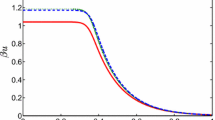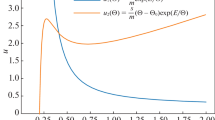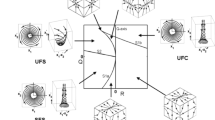Abstract
For combustion reactions with chain-branching kinetics, the time scales of induction and heat release vary independently and can be significantly different as well as comparable, depending on the initial conditions. A theoretical study was performed to investigate the influence of the heat-release rate and kinetics on the mechanisms and conditions of shock-wave formation in a spatially inhomogeneous combustible medium — the first step of detonation initiation in systems with an induction time gradient. The study used the transport equation method developed by the authors previously.
Similar content being viewed by others
References
Ya. B. Zel’dovich, V. B. Librovich, G. M. Makhviladze, and G. I. Sivashinsky “Development of detonation in a nonuniformly pre-heated gas,” Astronaut. Acta, 15, 313–321 (1970).
Ya. B. Zel’dovich, “Regime classification of an exothermic reaction with nonuniform initial conditions,” Combust. Flame, 39, 211–214 (1980).
B. E. Gel’fand, A. N. Polenov, S. M. Frolov, and S. A. Tsyganov “Detonation in systems with nonuniform temperature and concentration distributions,” Khim. Fiz., 5, No. 9, 1277–1284 (1986).
B. E. Gel’fand, S. M. Frolov, and S. A. Tsyganov “Mechanism of explosions in gas pumping units for gas mains,” Combust., Expl., Shock Waves, 24, No. 3, 356–358 (1988).
G. M. Makhviladze and D. I. Rogatykh, “Initial temperature and concentration inhomogeneities — the cause of explosive chemical reaction in a combustible gas,” Khim. Fiz., 8, No. 2, 272–285 (1989).
G. M. Makhviladze and D. I. Rogatykh, “Formation and attenuation of a quasi-steady-state detonation complex in a nonuniformly heated combustible gas,” Izv. Akad. Mauk SSSR, Mekh. Zhidk. Gaza, No. 2, 161–168 (1991).
M. Short, “On the critical conditions for the detonation initiation in a nonuniformly perturbed reactive fluid,” SIAM J. Appl. Math., 57, No. 5, 1242–1280 (1997).
A. K. Kapila, D. W. Schwendeman, J. J. Schwendeman, and T. Hawa, “Mechanisms of detonation formation due to a temperature gradient,” Combust. Theory Model., 6, 553–594 (2002).
G. J. Sharpe and M. Short, “Detonation ignition from a temperature gradient for a two-step chain-branching kinetics model,” J. Fluid Mech., 476, 267–292 (2003).
X. J. Gu, D. R. Emerson, and D. Bradley, “Modes of reaction front propagation from hot spots,” Combust. Flame., 133, 63–74 (2003).
A. M. Bartenev and B. E. Gelfand, “Spontaneous initiation of detonations,” Prog. Energ. Combust. Sci., 26, 29–55 (2000).
I. A. Zaev and I. A. Kirillov, “Transport equation for gas-dynamic perturbations in a spatially inhomogeneous self-igniting medium,” Combust., Expl., Shock Waves, 44, No. 3, 310–316 (2008).
I. A. Zaev and I. A. Kirillov, “Parametric study of shock-wave formation in a spatially inhomogeneous selfigniting medium for Arrhenius combustion kinetics,” Combust., Expl., Shock Waves, 45, No. 2, 174–181 (2009).
V. P. Korobeinikov, V. A. Levin, V. V. Markov, and G. G. Chernyi, “Propagation of blast waves in a combustible gas,” Astronaut. Acta., 17, Nos. 5–6, 529–537 (1972).
V. P. Korobeinikov, Problems of the Theory of Point Explosion [in Russian] Nauka, Moscow (1985).
N. M. Marinov, C. K. Westbrook, and W. J. Pitz, “Detailed and global chemical kinetic model for hydrogen,” Eighth (Int.) Symp. on Transport Processes (1995), Vol. 1, pp. 118–129.
M. Deminsky, V. Chorkov, G. Belov, I. Cheshigin, A. Knizhnik, E. Shulakova, M. Shulakov, I. Iskandarova, V. Alexandrov, A. Petrusev, I. Kirillov, M. Strelkova, S. Umanski, and B. Potapkin, “Chemical workbench — integrated medium for materials science,” Comput. Materials Sci., 28, 169–178 (2003).
Author information
Authors and Affiliations
Corresponding author
Additional information
__________
Translated from Fizika Goreniya i Vzryva, Vol. 45, No. 6, pp. 63–72, November–December, 2009.
Rights and permissions
About this article
Cite this article
Zaev, I.A., Kirillov, I.A. Theoretical description of shock-wave formation in a spatially inhomogeneous combustible medium for chain-branching combustion kinetics. Combust Explos Shock Waves 45, 692–699 (2009). https://doi.org/10.1007/s10573-009-0086-5
Received:
Published:
Issue Date:
DOI: https://doi.org/10.1007/s10573-009-0086-5




